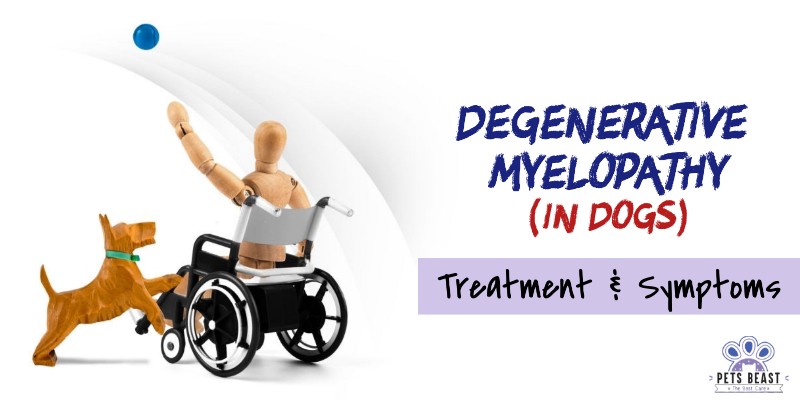What is DM? Degenerative myelopathy is a progressive disease involving the central nervous system, mainly the spinal cord, brainstem, and cranial nerves. It is the cumulative degeneration of the spinal cord, which is the relay between the brain and the limb muscles. These degenerations occur in the thoracolumbar region of the spinal cord and results in uncoordinated muscle movement of the rear limbs of the canines. The animal succumbs to the disease and eventually gets paralyzed or dies.
It might be difficult but please understand!
The owner needs to understand that currently, there is no cure to DM. It is only possible to add time to the dog’s life and make it mobile for the rest of its life because this degeneration cannot be stopped. Also, the good thing is that this condition is not painful for your dog.

Dogs Commonly Affected by Degenerative Myelopathy
DM is a disease of older dogs with 5- 14 years of age, most frequently the onset is at 7 years. DM is usually seen in German shepherd dogs but other breeds like Boxers, Retrievers, and Welsh Corgis are also diagnosed. Both sexes have equal susceptibility. It has been observed in both pure and mixed breeds. DM is a familial disease and it can be passed on to both sexes equally. Therefore a puppy can be normal, a carrier and affected, or affected depending upon the genes inherited by the parent dogs.
[box type=”info” align=”” class=”” width=””]Do you know? Degenerative Myelopathy is a human equivalent disease!
It is similar to ALS (Amyotrophic Lateral Sclerosis) in humans that causes stiffening of limb muscles. Both of these diseases are due to SOD1 gene mutation. DM also is considered an autoimmune disorder and therefore has a striking similarity with Multiple Sclerosis in humans.
[/box] [box type=”shadow” align=”” class=”” width=””]Symptoms of Degenerative Myelopathy in Dogs
Muscle weakness in Dog
Due to UMN Para paresis, muscle undergoes progressive deterioration. There is a lack of coordination in hind limbs. This condition id continues, leads to loss of spinal reflexes. Extreme muscle atrophy is the eventual result.
Can’t Stand properly
It is easily discernible that the dog is not able to bear its weight and is having difficulty in changing posture. The animal sways and stumbles. Legs lose strength and become wobbly. The state aggravates and the dogs end up paralyzed.
Ataxia
If it seems that your dog is drunk and presents with a tilted head, dizziness, stumbling, and buckling, immediately seek your vet. Lack of coordination and spinal cord injury has led to this state.
No signs of Pain
DM is an unpainful condition. If it seems that the dog is nauseous and is sensitive to touch, see your vet, it might not be DM.
Gait Disturbances
Lameness is an obvious feature. If the dog drags the hind limbs while walking and the knees buckle, let it rest.
Worn out Nails, Paralysis and Incontinency of urination and defecation
Due to dragging, the rear toes show injured nails. The canine may face paralysis and, disturbance in urination, defecation.
[/box] [box type=”shadow” align=”” class=”” width=””]The Four Stages of DM
DM has 4 stages as the disease progresses. Later stages may make the condition worse to be treated.
Stage 1:
- Para paresis (Both legs are paralyzed partially as the rear limb muscles are weakened)
- Wobbly gait
- Spinal reflexes remain intact
Stage 2:
- Paraplegia
- Incontinence
- Weakening spinal reflexes
Stage 3:
- Paralysis of both hind limbs
- Loss of muscle mass
Stage 4:
- Flaccid tetraplegia (all four limbs are paralyzed as the deteriorates the thoracic region too)
- Difficulty in swallowing and barking
Cause of Degenerative Myelopathy in Dogs
The cause of DM is undetermined but in some breeds, it is related to SOD1 gene mutation. The same gene id is responsible for ALS in humans-a motor neuron deficit.
It is also an autoimmune disease in which the patient’s immune system attacks its body cells leading to progressive damage of the neural tissue. Any genetic or environmental factors can be the cause of it. Immune attack on the nerve fibres destroys the myelin sheaths that are insulating them and this leads to a lack of coordination between brain and limbs. The results are obvious in the gait of the dog.
[/box] [box type=”shadow” align=”” class=”” width=””]Diagnosis of DM
Diagnosis of DM is made by using the method of elimination i.e. by eliminating the possibility of other diseases. This is because disc herniation, hip dysplasia, and cancer also show similar symptoms. Diagnostic tests are used to look for any other disease that is caused by spinal cord degeneration.
- Neurological examination
- X-Ray
- Electromyography
- MRI
- CT Scan
Lumbar Puncture
Dogs suffering from DM show an increased protein concentration in their CSF. Therefore spinal tap can be a distinguishing test to rule out the probability of other diseases.
Necropsy
It confirms the diagnosis of DM and the spinal cord changes that are obvious are not typical for other diseases.
Paw Replacement
It distinguishes between the neurological and orthopedic malignancies.
Saliva Test
A specimen of saliva is taken for DNA testing. This is taken by putting the swab in the mouth of the dog and taking the saliva from the inside of the cheek.
Genetic Tests
These tests do not diagnose DM but provide the probability of developing DM. By DNA testing and the study of the family history, it can be worked out if the dog is at the risk or is a carrier of DM, etc.
Home Care
DM patients need proper protocol. Make sure to keep the pet dry and tidy. Take care of the diet. Look for any infection due to incontinence. Foot care is also important. Keep a vigilant eye on the dog’s behaviour and talk to your vet. Provide it with proper nursing and keep it happy.
[/box] [box type=”shadow” align=”” class=”” width=””]Treatment of Degenerative Myelopathy
Sadly, no treatment can stop or considerably retard the degenerative process. Measures are taken to keep the dog comfortable for the rest of life.
Physiotherapy
Exercise can’t control the symptoms but it helps the dog in proprioception and balancing its body weight. It ensures proper circulation and maintains muscle tone and joint flexibility. But the owner should not let the dog get exhausted. It is better to make a proper exercise plan four days a week with proper rest.
Aquatic Therapy
Hydrotherapy has proved to be a gentle and safe method. It can help the canine grow muscle, though not considerably but it is better than running as it removes the factor of gravity. While swimming the dog can move without handling its weight. It improves the musculoskeletal system.
Assistive Equipment
Once the DM has been diagnosed, a wheelchair or harness will allow the dog in mobility. The handler will also find it comfortable to carry the dog with a stroller or sling.
Diet
Proteins, Omega-3 fat, and Vitamin supplements are sure to be added in the diet. Tonic herbs and selenium-containing food help alleviate the symptoms.
Medications
Though the condition is not painful painkillers like NSAIDs might be prescribed in case the dog is having problems with compensation of weight.
Anti-oxidants like Aminocaproic acid and N-Acetyl cysteine might help as a regimen. They help in immune system regulation.
Stem Cell Therapy
It is so far the most promising treatment and is speculated to possibly slow down or astonishingly reverse the progression of the disease. However, hitherto controlled studies have not been performed.
Euthanasia
As the condition is progressive, irreversible, and extremely devastating, therefore the owner might need to consider the option of putting the animal to sleep. It might not be easy but it is better not to make the animal suffer.
Prognosis
As it has been understood that no treatment can truly cure DM and nothing can stop it from progressing, the prognosis is usually poor. The treatments can enhance the quality of the life the dog leads minimizing the difficulty it may go through.
Without treatment, the dog lives for a couple of months or more. With proper care and treatment, the dog may live for 3 years.
However, some owners decide euthanasia preventing the dog from further suffering.
[/box] [box type=”shadow” align=”” class=”” width=””]Costs of Treating Degenerative Myelopathy
DM treatment for your dog may turn out to be expensive therefore, it is always a good decision to discuss the way of treatment you choose for your pet and the finances openly with your vet. Diagnostic tests and the treatment combined would cost roughly $2K to $4K.
[/box] [tie_list type=”lightbulb”]- German Shepherd Breed: Traits & Personality
- Life Span of German Shepherd Dogs
- Best German Shepherd Dog Foods
- German Shepherd Weight
- Why Does The Ears of German Shepherd Stand Up?
- How Much Does a German Shepherd Cost?
- Why Do German Shepherds Jump?
- Are German Shepherds Good Service Dogs?
Take care!
Your pet needs proper care and attention. It better not to make it suffer. Visit a vet twice a year for physical examination and health assessment. Things get harder if the pet is getting older. If it gets afflicted with an incurable disease and pet can’t put up with the agony, compromise on euthanasia.








